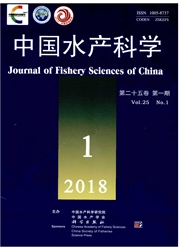

 中文摘要:
中文摘要:
工厂化流水养殖条件下进行为期90 d的饲养试验,探讨养殖密度对杂交鲟[西伯利亚鲟(Acipenser baerii)(♀)×施氏鲟(Acipenser schrenckii)(♂)]幼鱼生长性能、肌肉组分含量和血液生理指标的影响。杂交鲟初始体重为(251.11±0.59)g,养殖密度分别设置为5.50 kg/m3、8.27 kg/m3、11.01 kg/m3、13.80 kg/m3。结果表明,养殖密度对杂交鲟幼鱼的生长和存活影响显著(P〈0.05),随着养殖密度的增加,幼鱼的终末体重、特定生长率、肥满度和存活率呈下降趋势,而饲料系数则呈上升趋势;实验结束时,杂交鲟幼鱼肌肉中水分含量随养殖密度的增加而上升(P〈0.05),而粗脂肪含量却下降(P〈0.05),粗蛋白和灰分的含量则变化不显著(P〉0.05);养殖密度对杂交鲟幼鱼的血液指标影响显著(P〈0.05),各处理组的幼鱼血液中血红蛋白、血浆葡萄糖及总蛋白含量差异显著(P〈0.05)。结果说明,高密度环境对杂交鲟幼鱼生长性能与肌肉组分均产生了显著影响。
 英文摘要:
英文摘要:
We conducted a 90-day experiment in 12 flow-through tanks to evaluate the influence of stocking density on growth performance, muscle composition, and blood biochemical parameters in juvenile hybrid sturgeon [Acipenser baerii (♀) x Acipenser schrenckii (♂)]. Sturgeon (mean total length: 31.55±1.50 cm; mean body weight: 251.11±0.59 g) were randomly distributed into four different stocking density groups of G1 (5.50 kg/m3, 200 fish/pond), G2 (8.27 kg/m3, 300 fish/pond), G3 (11.01 kg/m3, 400 fish/pond), and G4 (13.80 kg/m3, 500 fish/pond). The results show that stocking density had significant effects on the growth and survival of juvenile hybrid sturgeon (P〈0.05). Survival rates at the end of the experiment were 99.33%, 97.67%, 95.33%, and 92.80% in the G1, G2, G3, and G4 groups, respec- tively. Final body weight, specific growth rate, and condition factor decreased with an increase in stocking density, whereas the food conversion ratio showed the opposite tendency. Muscle moisture content increased significantly with the increase in stocking density, whereas crude muscle lipid content decreased significantly (P〈0.05). However, no significant difference was observed in ash or crude protein content. Differences between treatments were detected for glucose, total protein, and hemoglobin. In conclusion, these results suggest that a high juvenile hybrid sturgeon stocking density could negatively influence growth, muscle composition, and blood biochemical parameters.
 同期刊论文项目
同期刊论文项目
 同项目期刊论文
同项目期刊论文
 期刊信息
期刊信息
